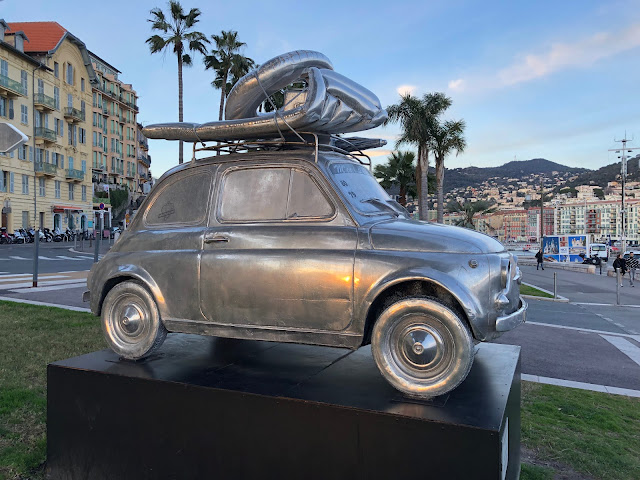Side Trips: Nice and Monaco
 |
| Commemorating the whole family piling into the Fiat Cinquecento for a Sunday at the beach in Nice. |
I'm not a crowds person, which might make Paris an odd choice as a place to live. But unlike, say, Pier 39 in San Francisco, there's no question in my mind that the tourists who come to Paris to enjoy the food, culture and history are making a good decision--although for the life of me I can't fathom why people would wait for hours to catch a glimpse of the Mona Lisa. From what I can tell, it's an undersized portrait that no one but Leonardo collectors and art aficionados cared about until newspapers and magazines sensationalized its 1911 theft by a Louvre employee. There were other copies in existence before then, and anyone who wants to appreciate the painting's composition and craftsmanship would do better with a Taschen coffee table book. I myself vastly prefer Mona Gorilla, in any case.
My love of the ocean also makes landlocked Paris a strange base of operations--until you consider that I don't really lay on beaches in the sun. All of which means that enjoying the ocean in France without dealing with crowded beach scenes meant a trip to Nice in January. Nice is a quintessential mediterranean summer getaway. Which is why even in January, the town felt, well, mediterranean. Both the port and the main beach seem to function as the town center--or at least the place to funnel the hordes. The town has been destroyed by siege a few times, so what remains of the "older" architecture is mainly from the 19th century and painted in oranges, pinks and yellows. From the Parc de la Colline du Château--the site of a military citadel destroyed in 1705 on the order of the Sun King as a middle finger to the Duke of Savoy--you can see the Mediterranean sea, the red-tiled roofs (why isn't it rooves?) of the town and the snow-capped French Alps in the distance.
 |
| Views from the Parc de la Colline du Château. |
.jpeg) |
| The Maison Tordo, a building of no discernible renown, but for some reason people seem attracted to it. |
 |
| Our selfie at the Sky Mirror (1999) in front of the Casino de Monte-Carlo. |
What I really liked about Monaco, though, was for a city of tremendous wealth, it had a very playful, even laid-back, atmosphere. This showed most strongly in the public sculptures scattered throughout the town, an art initiative begun under Prince Rainier III (who reigned from 1949 to 2005). You sort of wander from piece to piece on the cliffside stroll over the Mediterranean or though the botanical gardens from the Jardin des Pêcheurs to the Musée Oceanographique, and right up to the Prince's residence.



.jpeg)



Comments
Post a Comment